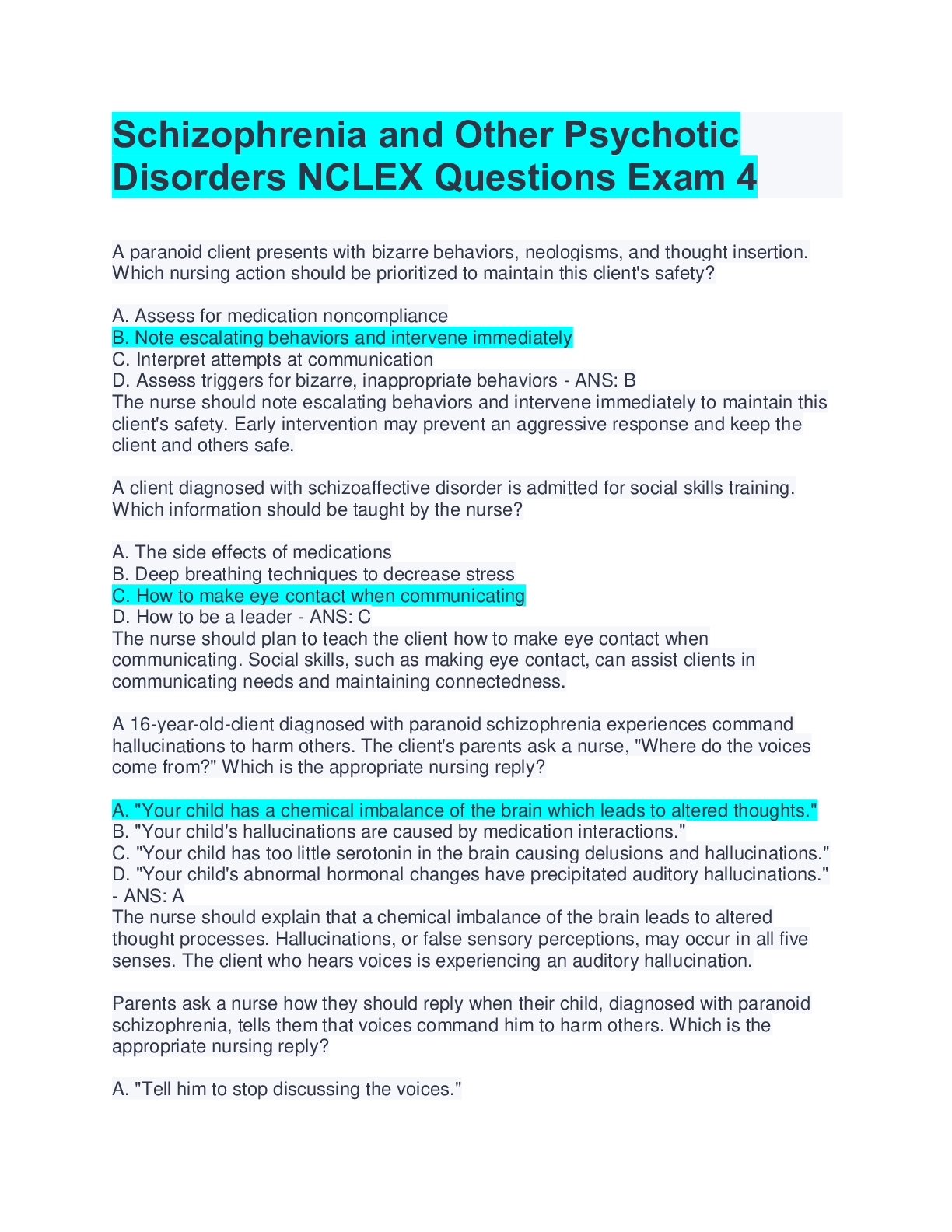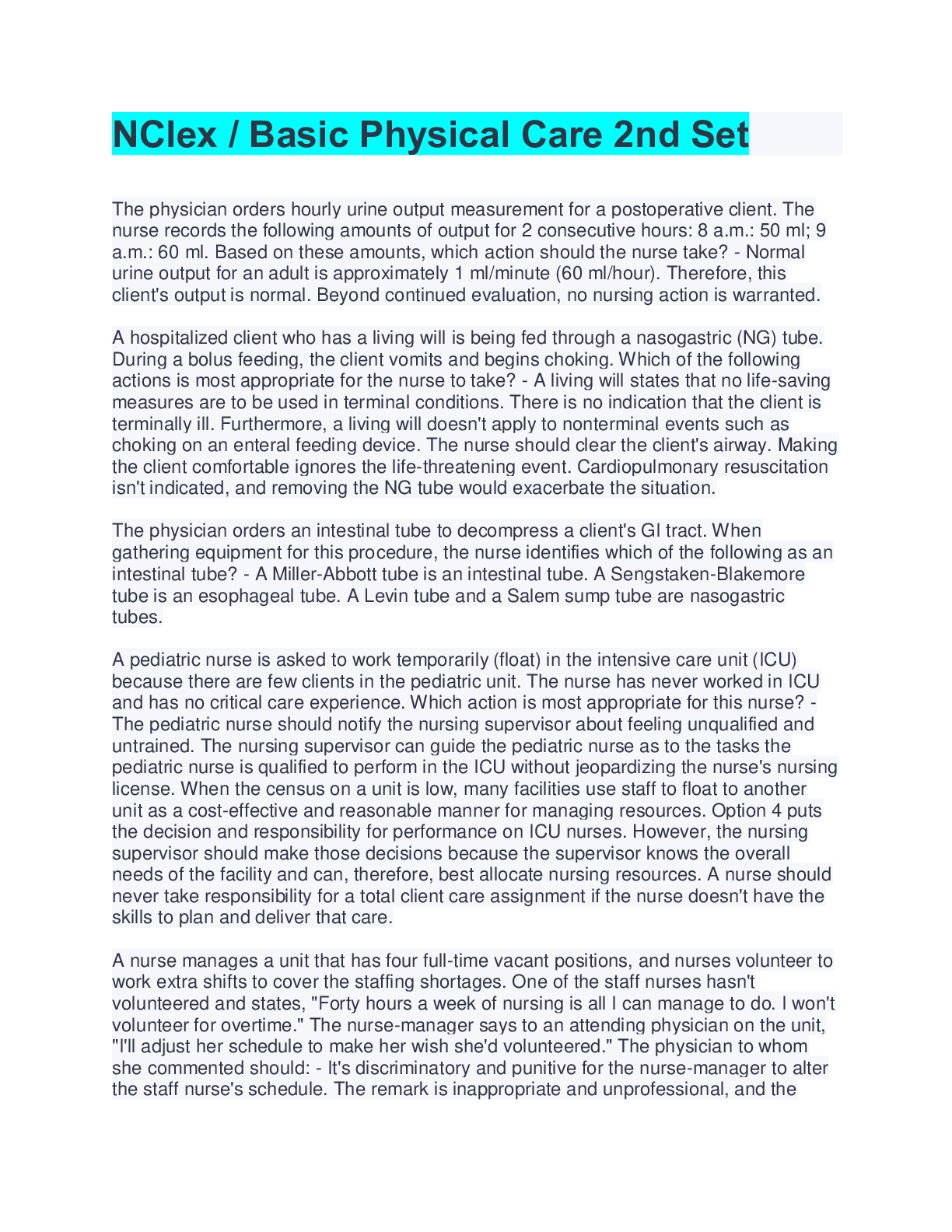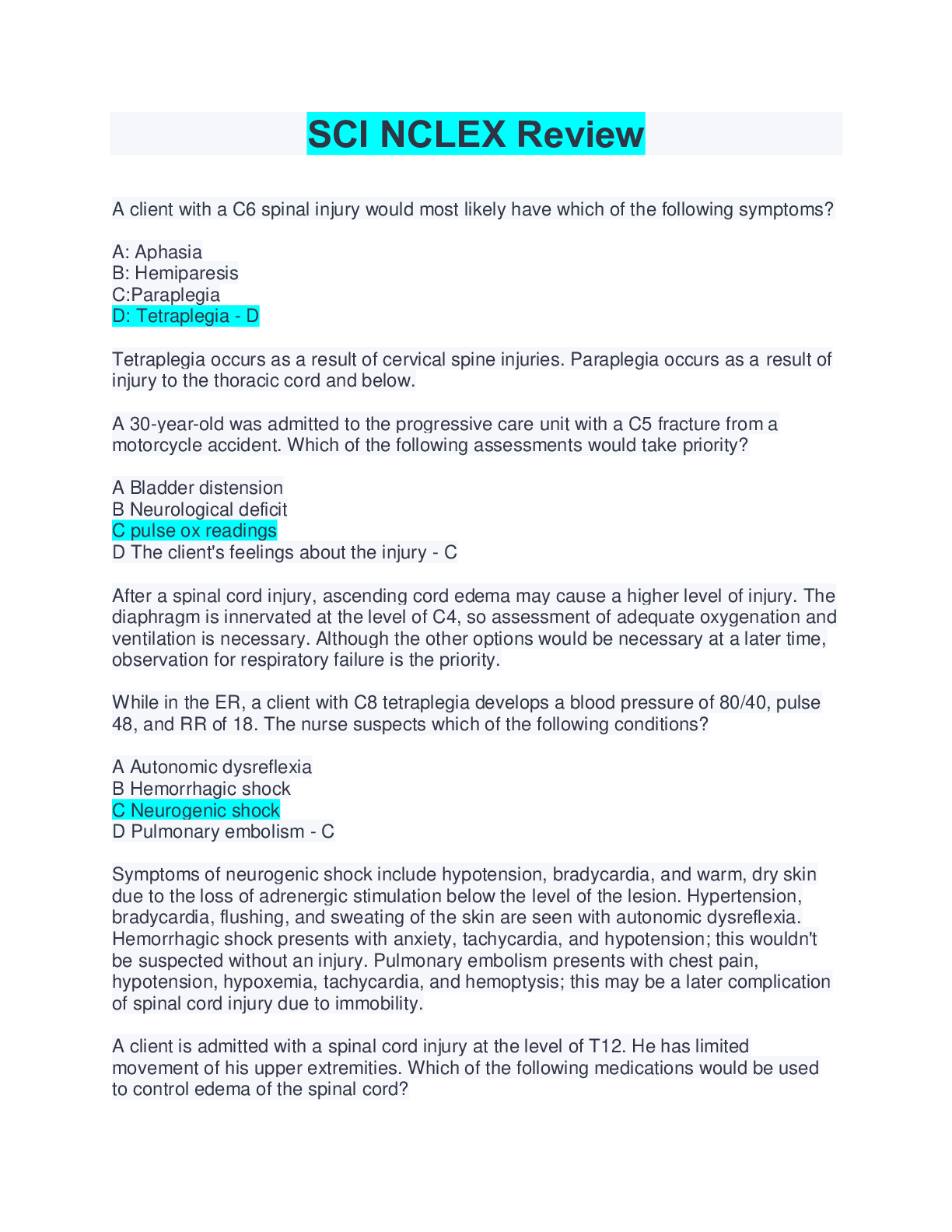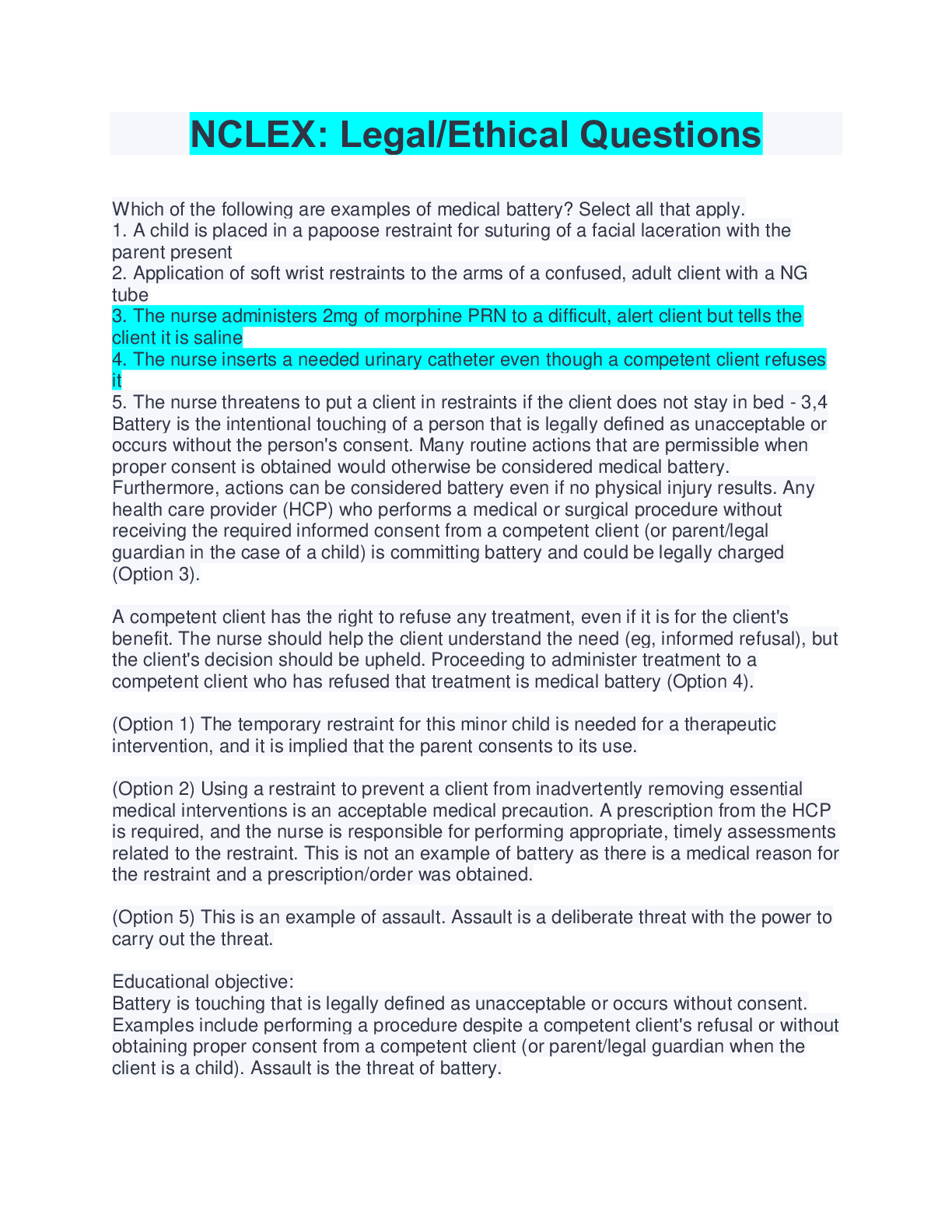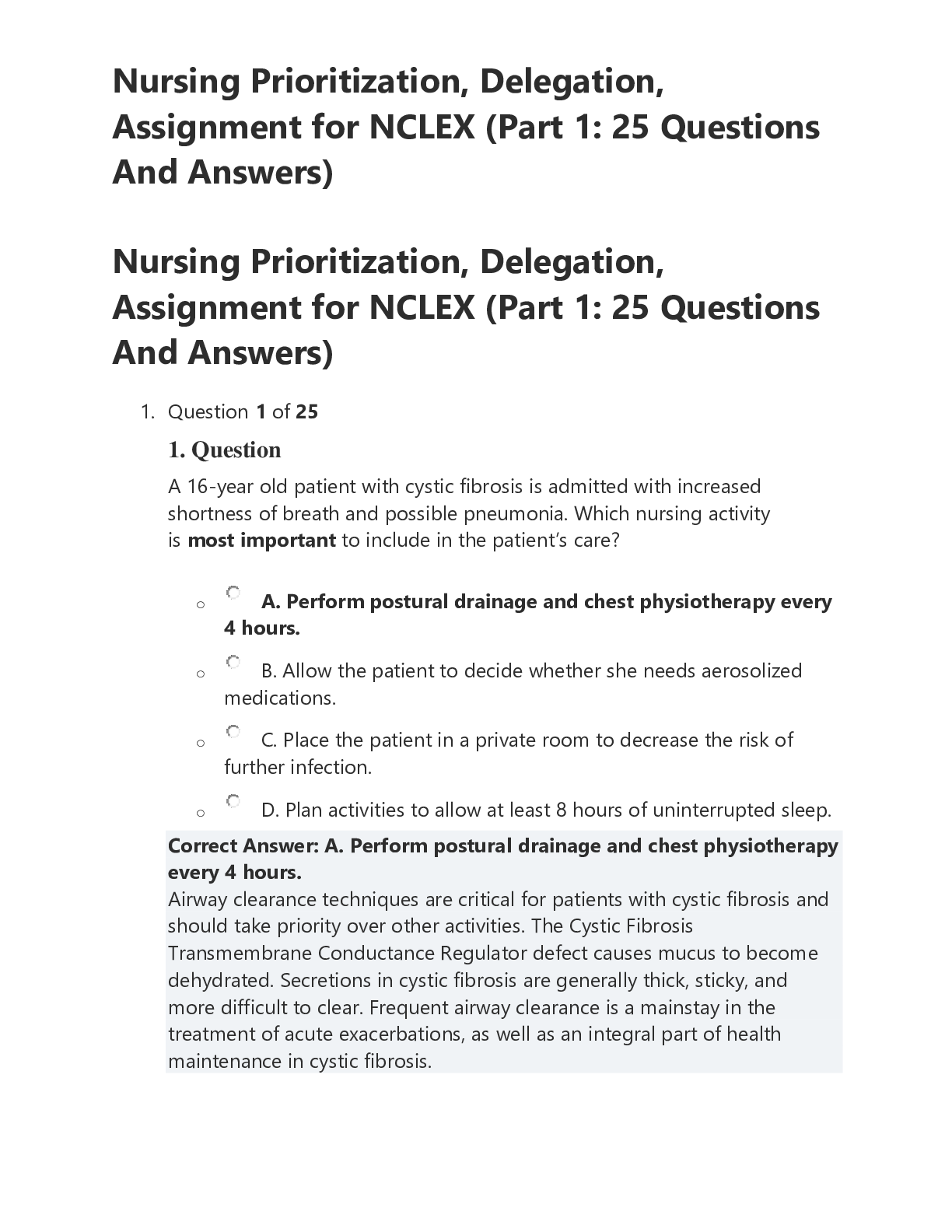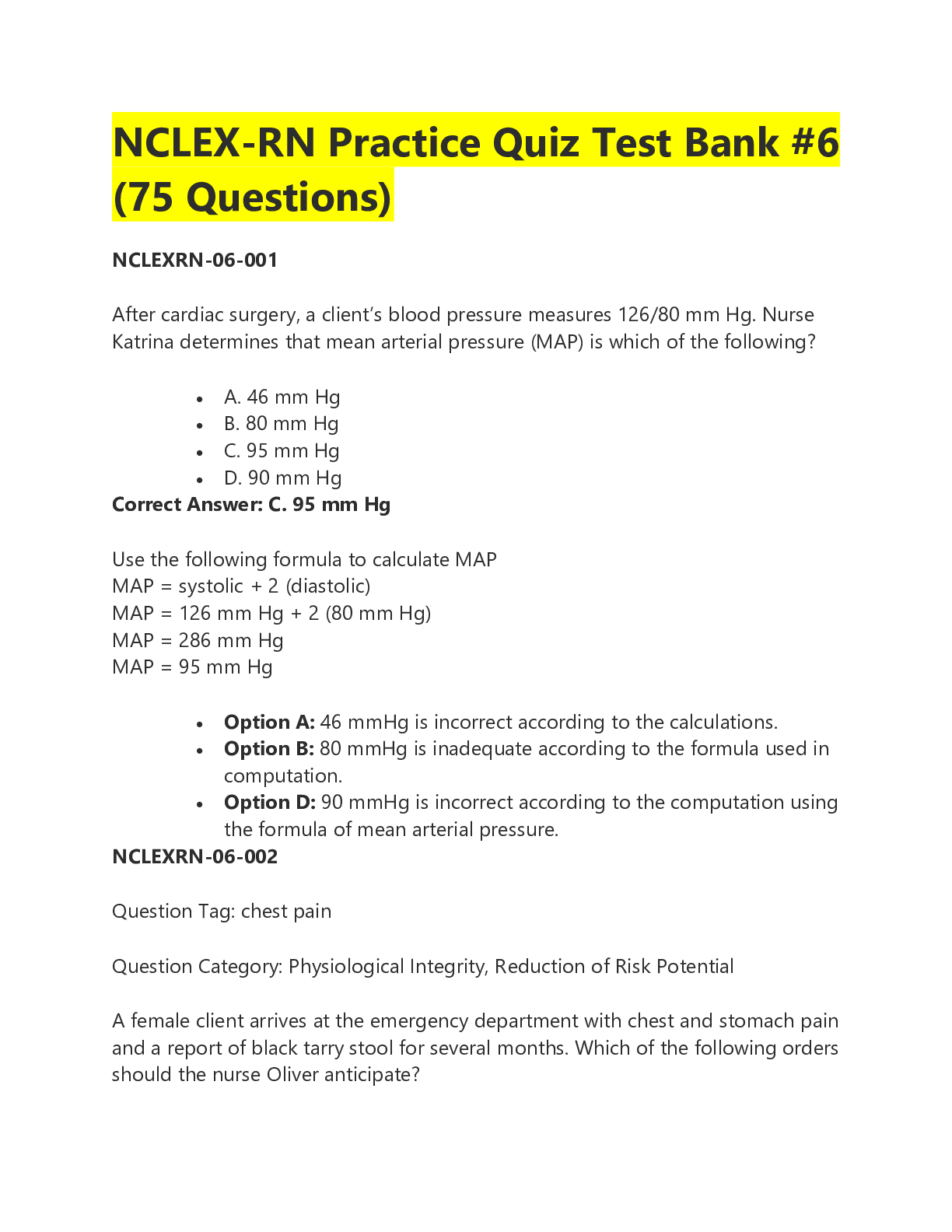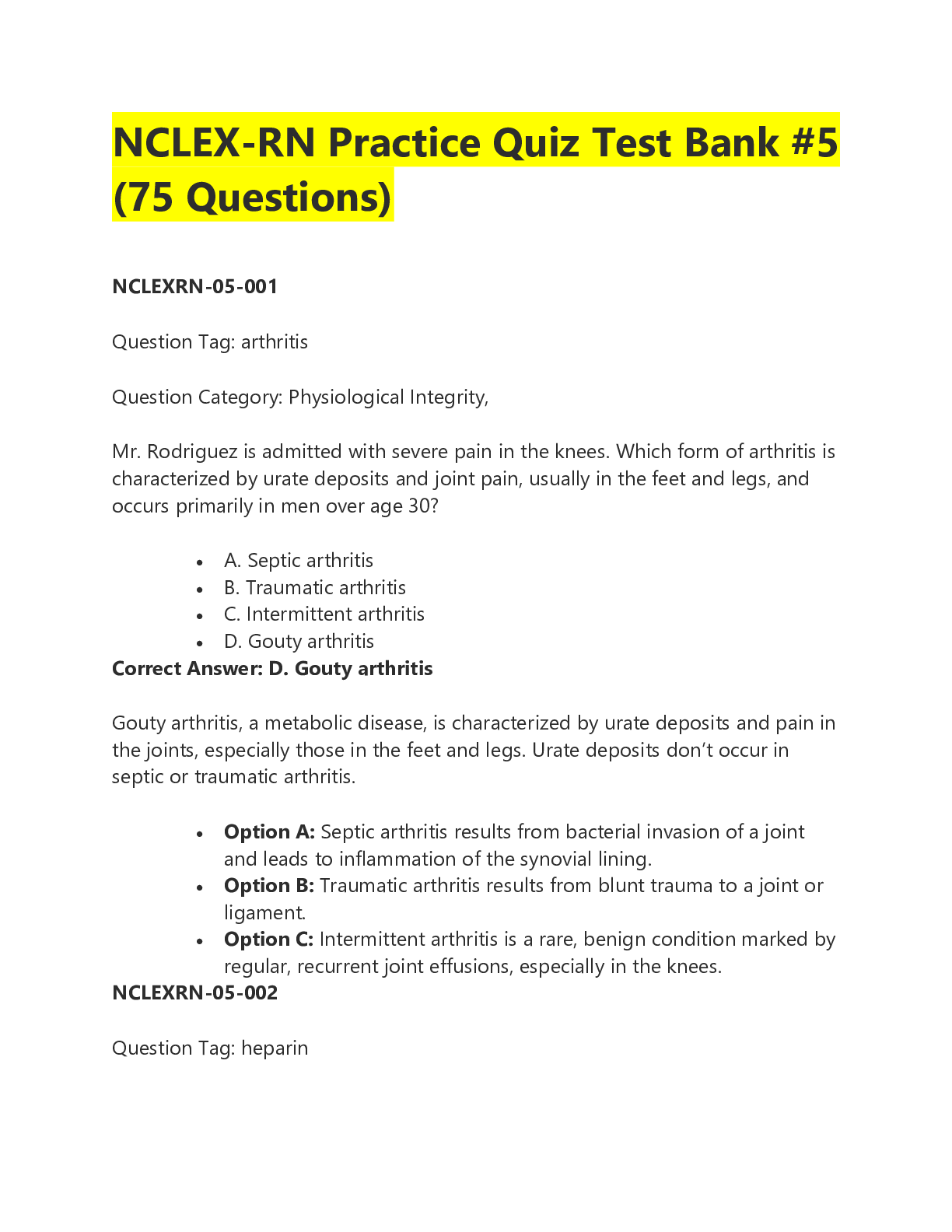*NURSING > NCLEX > Touhy & Jett: Ebersole and Hess’ Gerontological Nursing & Healthy Aging, 5th Edition/Chapter 06: G (All)
Touhy & Jett: Ebersole and Hess’ Gerontological Nursing & Healthy Aging, 5th Edition/Chapter 06: Gerontological Nursing Across the Continuum of Care
Document Content and Description Below
Chapter 06: Gerontological Nursing Across the Continuum of Care Touhy & Jett: Ebersole and Hess’ Gerontological Nursing & Healthy Aging, 5th Edition MULTIPLE CHOICE 1. An older female re... sident in the residential facility keeps a large collection of personal items and photographs of her late husband on her bedside table, but the nursing assistant and resident frequently argue about this. Why should the nurse intervene between the resident and the nursing assistant? NURSINGTB.COM 2. Which statement is true about living arrangements for older adults? 3. Which statement is true about residential living for older adults? 4. A resident of a long-term care facility has been asking to have the drain in the bathroom sink repaired for 2 months. The nurse responds by saying that when they move to the new building, the sinks will work very well. Which right of a resident of a long-term care facility has the nurse violated? 5. A nursing home is converting to a person-centered culture from an institution-centered culture. Which nursing intervention will be suitable in the new culture? 6. The nurse prepares to transfer an older adult to a long-term care facility and calls the facility to give a report. Which nursing actions are the responsibilities of both the transferring nurse and the receiving nurse? a. Incorporating patient goals into the plan b. Ensuring the patient is stable for transfer c. Supplying patient documents for planning d. Providing continuity of care during the transfer ANS: D A shared responsibility of the sending and the receiving nurses or care team is to regard the transition as a transfer versus a discharge and to provide continuous and consistent nursing care throughout the transfer phase. To accomplish this, the two nurses or groups must have clear, comprehensive communication. The receiving nurse incorporates patient goals into the plan. The sending nurse ensures that the patient is stable for the transfer to prevent decompensation during the trip or shortly after arrival at the new facility. The sending nurse is responsible for providing clear, comprehensive, and complete patient documentation. PTS: 1 DIF: Understand REF: p. 74-76 TOP: Nursing Process: Assessment MSC: Safe, Effective Care Environment 7. A nurse completing a hospital discharge to home understands that which of the following interventions is most important before discharge? a. Medication reconciliation b. Providing a list of community resources c. Contacting a durable medical equipment facility d. Educating the client on appropriate range-of-motion exercises ANS: A NURSINGTB.COM Medication reconciliation is the most important intervention to complete before discharge. Medication discrepancies are the most prevalent adverse event after hospital discharge and the most challenging component of a successful hospital-to-home transition. Nurses’ attention to an accurate prehospital medication list, medication reconciliation during hospitalization and at discharge, and patient and family education about medications are required to enhance safety. Educating the client on appropriate range-of-motion exercises, providing a list of community resources, and contacting a durable medical equipment facility are all important and should be completed as well, but medication reconciliation should be the priority. PTS: 1 DIF: Apply REF: p. 74-76 TOP: Nursing Process: Implementation MSC: Safe, Effective Care Environment 8. An older couple who lives in their own home is considering relocating to a continuing care retirement community (CCRC). The wife is independent in activities of daily living and volunteers at a homeless shelter twice a week. The husband recently had a stroke and is undergoing rehabilitation in a long-term care facility. One benefit of a CCRC for this couple is a. for married couples in which one spouse needs more care than the other, a CCRC allows them to live nearby in different parts of the same community. b. a CCRC provides high-quality care at a lower cost than other programs. c. a CCRC provides social and health services to adults who need supervised care in a safe setting during the day. d. a CCRC is more cost effective than a nursing home and provides care in a homelike environment. ANS: A Life care communities, also known as CCRCs, provide the full range of residential options, from single-family homes to skilled nursing facilities, all in one location. For married couples in which one spouse needs more care than the other, life care communities allow them to live nearby in a different part of the same community. Choosing to live in a CCRC is a costly endeavor, and individuals with low or even middle incomes and assets usually can’t afford this senior housing option. Adult day programs provide social and some health services to adults who need supervised care in a safe setting during the day. PTS: 1 DIF: Apply REF: p. 67-68 TOP: Nursing Process: Assessment MSC: Safe, Effective Care Environment 9. A nurse in an assisted living facility (ALF) evaluates the application for admission of an elderly woman. The woman is 87 years old, needs assistance with bathing and dressing, and is unable to prepare her own meals or do her own housekeeping. The nurse compares this applicant with the typical residents of an ALF and concludes which of the following? a. This woman is not a typical resident of an ALF and is better suited to a long-term care facility. b. This woman matches the profile of a typical resident in an ALF. c. This woman is not a typical resident of an ALF and is better suited for an adult day care program. d. This woman is not a typical resident of an ALF and is better suited for a Program for All-Inclusive Care for the Elderly (PACE) Program. ANS: B The profile of a resident in anNaUsRsisSteIdNliGviTngBf.acCilOityMis a woman, approximately 87 years old, who needs assistance with two to three activities of daily living and needs help with meal preparation and managing medications. PTS: 1 DIF: Analyze REF: p. 68-69 TOP: Nursing Process: Assessment MSC: Safe, Effective Care Environment 10. A nurse is considering employment in an assisted living facility (ALF). The nurse understands that which of the following are true about nursing in an ALF? a. A registered nurse (RN) is required to supervise residents 24 hours per day in an ALF in all states in the United States. b. Not all states require an RN in ALFs; however, many do employ RNs. c. An RN is not required to supervise residents in all states in the United States, however, a licensed practice nurse (LPN) is required. d. An RN is required to supervise residents 12 hours per day in an ALF in all states in the United States. ANS: B Not all states in the United States require an RN in an ALF; however, between 47% and 70% employ an RN or an LPN or licensed vocational nurse. PTS: 1 DIF: Remember REF: p. 68-69 TOP: Nursing Process: Assessment MSC: Safe, Effective Care Environment 11. An older patient is being discharged from the hospital to a subacute unit. The patient says to a nurse, “I am not sure I understand the difference between a subacute unit and a nursing home. Can you help me understand?” The nurse considers which of the following in formulating a response? a. Subacute care and nursing home care are identical. b. Subacute care is more intensive than traditional nursing home care. c. Subacute care is reimbursed by either Medicaid or private pay. d. Professional nursing staff levels are the same as those in traditional nursing home settings. ANS: B Subacute care is more intensive than traditional nursing home care and is reimbursed by Medicare. Professional staffing levels tend to be higher than in traditional nursing home settings. PTS: 1 DIF: Remember REF: p. 69-70 TOP: Nursing Process: Assessment MSC: Safe, Effective Care Environment MULTIPLE RESPONSE 1. A family is touring selected nursing homes in preparation for their mother’s future. Which qualities of a nursing home should the family include if they decide on a person-centered nursing home? (Select all that apply.) a. Staff members cover all nursing units. b. Residents and families have a council. c. Residents choose stimulating activities. d. Staff members respond toNresRidenIts’GneeBds.. C M e. Group activities are scheduled on the hour. f. Staff members help residents stay well-groomed. ANS: B, C, D, F A characteristic of a person-centered culture is family and resident councils to discuss resident issues, needs, and solutions. A second characteristic of a person-centered culture is residents choosing their own activities to suit their interests. A third characteristic of a person-centered culture is a responsive staff that promptly meets resident needs. A fourth characteristic of a person-centered culture is assisting residents to maintain their appearance and to stay well-groomed. Consistent nursing assignments are a characteristic of a person-centered culture. Predetermined schedules are characteristic of an institution-centered culture. PTS: 1 DIF: Understand REF: p. 74 TOP: Nursing Process: Assessment MSC: Safe, Effective Care Environment 2. An elder-friendly community includes components that (Select all that apply.) a. address basic needs. b. optimize physical health. c. provide financial assistance. d. maximize independence. e. provide social engagement. ANS: A, B, D, E Components of an elder-friendly community include addressing basic needs, optimizing physical health and well-being, maximizing independence for frail and disabled older adults, and providing social and civic engagement. Elder-friendly communities do not provide financial assistance. PTS: 1 DIF: Understand REF: p. 66-67 TOP: Nursing Process: Assessment MSC: Safe, Effective Care Environment 3. Which home modification interventions are designed to enhance the ability of older adults to remain in their homes? (Select all that apply.) a. A 36-inch-wide doorway b. Entryways with less than two steps c. Electrical outlets at chest level d. A bathroom on the first floor ANS: A, D Many state and local governments are assessing the community and designing interventions to enhance the ability of older people to remain in their homes and familiar environments. Home design features such as 36-inch-wide doorways and hallways, a bathroom on the first floor, an entry with no steps, outlets at wheelchair level, and reinforced walls in bathrooms to support grab bars. PTS: 1 DIF: Understand REF: p. 66-67 TOP: Nursing Process: Assessment MSC: Safe, Effective Care Environment 4. An older patient’s daughter asks a nurse the following: “I have heard about PACE [Program for All-Inclusive Care for the Elderly] programs and think that one might be a good option for my father. Can you tell me mNoUreRaSboIuNt wGhTatBt.heCqOuaMlifications to be part of a PACE program are?” The nurse includes which of the following in her response to the family member? (Select all that apply.) a. PACE programs provide services to individuals who meet the criteria for nursing home admission. b. PACE programs only provide service to individuals who are age 55 years and over. c. Participants in PACE programs must be eligible for either Medicare or Medicaid. d. Participants in PACE programs must be able to perform their own activities of daily living (ADLs) independently. e. Participants in PACE programs must have been residents in a nursing home before enrollment in the PACE program. ANS: A, B PACE provides community services to people age 55 years and older who meet the criteria for nursing home admission, prefer to remain in the community, and are eligible for Medicare and Medicaid. There are no qualifications that address ADL status. PTS: 1 DIF: Understand REF: p. 67 TOP: Nursing Process: Assessment MSC: Safe, Effective Care Environment 5. Which of the following are true about long-term care? (Select all that apply.) a. The number of older adults needing long-term care services is expected to increase exponentially in the next 25 years. b. Most long-term care is paid for by Medicare. c. Long-term care is the most cost effective manner in which to care for older adults. d. Most individuals in the United States have purchased long-term care insurance. e. Costs of long-term care have outpaced inflation since 2003. ANS: A, E Long-term care is expensive and becoming more expensive; costs have outpaced inflation since 2003. The number of older people needing long-term care services and supports is dramatically increasing year after year. Worldwide, the number of people older than age 80 years—those most likely to need long-term care services—will increase by 233% between 2008 and 2040. A fivefold increase in spending on long-term care is projected by 2045 in the United States. Most Americans do not have long-term care insurance and have not planned for their long-term care needs. Long-term care is paid for by Medicaid and private pay. PTS: 1 DIF: Understand REF: p. 70 TOP: Nursing Process: Assessment MSC: Safe, Effective Care Environment 6. A nurse is educating the family of an older patient about long-term care. The nurse understands that goals of long-term care include which of the following? (Select all that apply.) a. To preserve individual autonomy b. To provide the most cost effective care possible c. To prevent readmission to the acute care setting d. To restore and maintain the highest level of independence e. To create a homelike environment that respects individual dignity ANS: A, D, E Goals of long-term care incluNdUe:RSINGTB.COM Provide a safe and supportive environment for chronically ill and functionally dependent people. Restore and maintain highest practicable level of functional independence. Preserve individual autonomy. Maximize quality of life, well-being, and satisfaction with care. Provide comfort and dignity at the end of life for residents and their families. Provide coordinated interdisciplinary care to subacutely ill residents who plan to return to home or a less restrictive level of care. Stabilize and delay progression, when possible, of chronic medical conditions. Prevent acute medical and iatrogenic illnesses and identify and treat them rapidly when they do occur. Create a homelike environment that respects the dignity of each resident. PTS: 1 DIF: Understand REF: p. 70 TOP: Nursing Process: Assessment MSC: Safe, Effective Care Environment [Show More]
Last updated: 1 year ago
Preview 1 out of 7 pages
Instant download

Buy this document to get the full access instantly
Instant Download Access after purchase
Add to cartInstant download
Reviews( 0 )
Document information
Connected school, study & course
About the document
Uploaded On
Aug 08, 2021
Number of pages
7
Written in
Additional information
This document has been written for:
Uploaded
Aug 08, 2021
Downloads
0
Views
52


